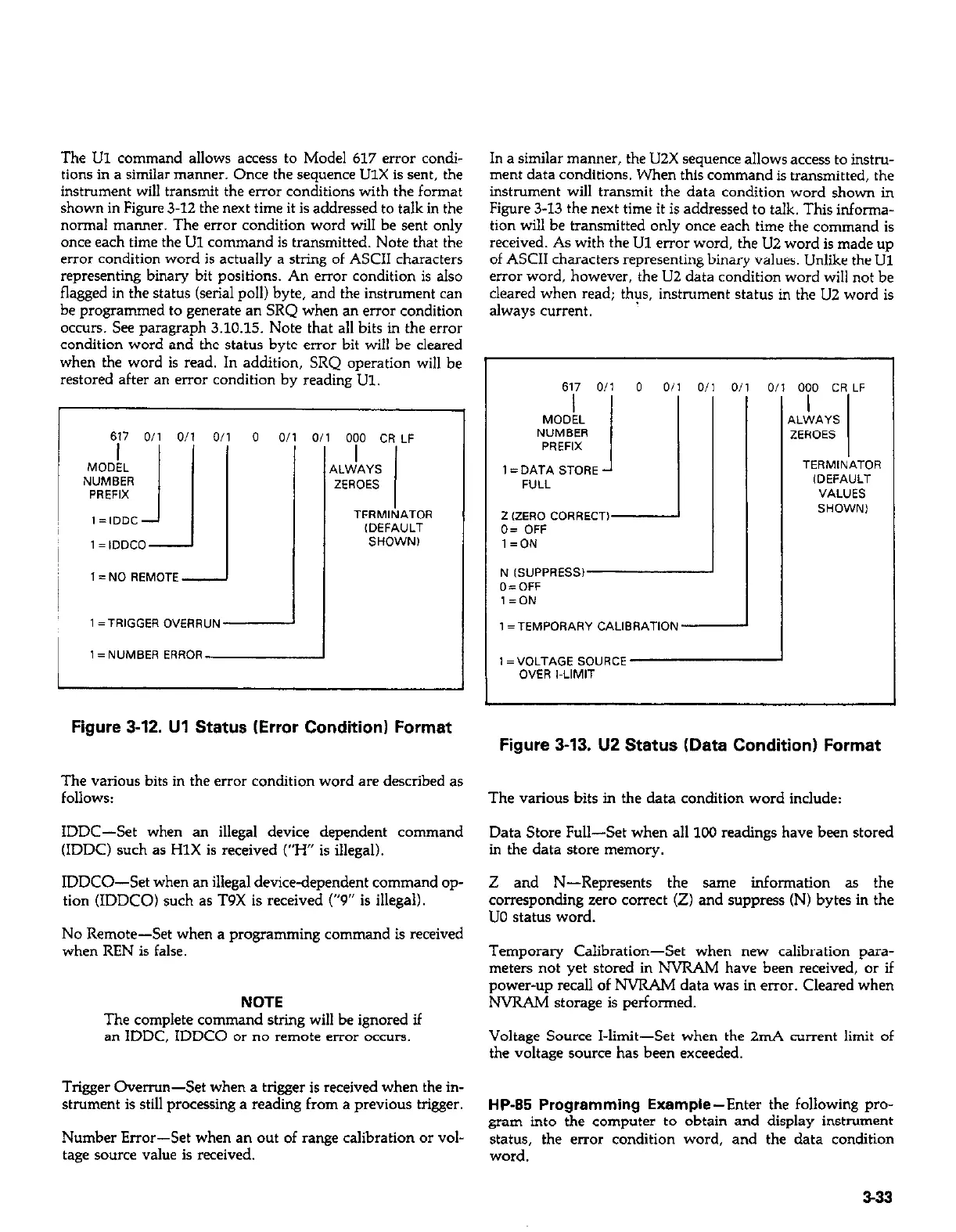The Ul command allows access to Model 617 error condi-
tions in a similar manner. Once the sequence UlX is sent, the
instrument will transmit the error conditions with the format
shown in Figure 3-12 the next time it is addressed to talk in the
normal manner. The error condition word will be sent only
once each time the Ul command is transmitted. Note that the
error condition word is actually a string of ASCII characters
representing binary bit positions. An error condition is also
flagged in the status (serial poll) byte, and the instrument can
be programmed to generate an SRQ when a” error condition
OCCWS. See paragraph 3.10.15. Note that all bits in the error
condition word and the status byte error bit will be cleared
when the word is read. In addition, SRQ operation will be
restored after an error condition by reading Ul.
r
617 Oil O/l 0,
I= IDDCO-
1= NO REMOTE -
0 0
1 1 = NUMBER ERROR
000 CR LF
,LWAYS
ZEROES
TERMINATOR
(DEFAULT
SHOWN1
1
Figure 3-12. Ul Status (Error Condition) Format
The various bits in the error condition word are described as
follows:
IDDC-Set when a” illegal device dependent command
(IDDC) such as HlX is received (“H” is illegal).
IDDCO-Set when a” illegal device-dependent command op-
tion (IDDCO) such as T9X is received (“9” is illegal).
No Remote-Set when a programming command is received
when REN is false.
NOTE
The complete command string will be ignored if
an IDDC. IDDCO or no remote error occurs.
Trigger Overrun-Set when a trigger is received when the in-
strument is still processing a reading from a previous trigger.
Number Error-Set when a” Out of range calibration or vol-
tage source value is received.
In a similar manner, the U2X sequence allows access to instru-
ment data conditions. When this command is transmitted, the
instrument will transmit the data condition word shown in
Figure 3-13 the next time it is addressed to talk. This informa-
tion will be transmitted only once each time the command is
received. As with the Ul error word, the U2 word is made up
of ASCII characters representing binary values. Unlike the Ul
error word, however, the LIZ data condition word will not be
cleared when read; thps, instrument status in the U2 word is
always current.
617 Oil 0 Oil o/1 0.
MODEL
NUMBER
PREFIX
1 = DATA STORE J
FULL
2 (ZERO CORRECT)
0= OFF
l=ON
N (SUPPRESS1
O=OFF
l=ON
1 =TEMPORARY CALlSRATlON-
0,
iI
1 =“OLTAGE SOURCE
OVER I-LIMIT
A
000 CR LF
I
.LWAYS
!EROES
TERMINATOR
,DEFAULT
VALUES
1
Figure 3-13. U2 Status (Data Condition) Format
The various bits in the data condition word include:
Data Store Full-Set when all 100 readings have been stored
in the data store memory.
Z and N-Represents the same information as the
corresponding zero correct (Z) and suppress (N) bytes in the
UO status word.
Temporary Calibration-Set when new calibration para-
meters not yet stored in NVRAM have been received, or if
power-up recall of NVRAM data was in error. Cleared when
NVRAM storage is performed.
Voltage Source I-limit-Set when the 2mA current limit of
the voltage source has been exceeded.
HP-85 Programming Example-Enter the following pro-
gram into the computer to obtain and display instrument
status, the error condition word, and the data condition
word.
3-33
